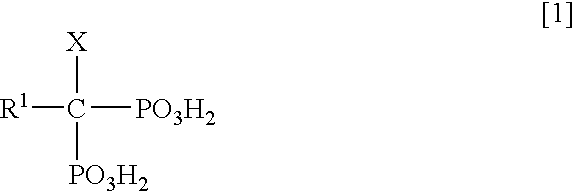Cleaning Agent for Substrate and Cleaning Method
- Summary
- Abstract
- Description
- Claims
- Application Information
AI Technical Summary
Benefits of technology
Problems solved by technology
Method used
Image
Examples
examples 1 to 44
[0110] Each of the wafer contaminated with a carbon defect, the wafer provided with a Cu-BTA film and the metallic Cu deposited wafer, which were prepared by the above-described methods, was dipping in 1 L of each cleaning agent described in Table 1 at room temperature for 5 hours. Thereafter, each of waters was taken out, rinsed with ultra pure water for 10 min, and spin-dried.
[0111] As to the wafer contaminated with a carbon defect thus treated, presence of the carbon defect adsorbed and remaining on said wafer surface was confirmed to evaluate capability of removing carbon defect, by direct measurement using an Auger photoelectron spectroscopic analyzer.
[0112] And as to the wafer provided with a Cu-BTA film, thickness of a Cu-BTA film on the wafer surface was measured to confirm an influence (occurrence of dissolution and elution) on the Cu-BTA film.
[0113] Further, as to the metallic Cu deposited wafer, color tone of a Cu film surface on the wafer surface was checked by visual...
examples 45 to 76
[0122] Each of the wafers contaminated with metals prepared by the above-described method was dipped in 1 L each of cleaning agents described in Table 4, at room temperature for 1 hour. Thereafter, the wafer was taken out, rinsed with ultra pure water for 10 min, and spin-dried.
[0123] For the wafers contaminated with metals thus treated, remaining metal concentrations (remaining Fe concentration, remaining Al concentration, and remaining Cu concentration) adsorbed and remaining on a surface of the wafer were measured, to evaluate capability of removing metallic impurities.
[0124] The results are shown in Table 4.
TABLE 4remainingremainingremainingconc.Complex-conc.conc.Fe conc.Al conc.Cu conc.Ex.Organic acid(% by WT)ing agent(% by WT)Organic solvent(% by WT)pH(Fe atom / cm2)(Al atom / cm2)(Cu atom / cm2)45citric acid5—methanol0.224 × 10139 × 10122 × 101246acetic acid5—methanol0.226 × 10124 × 10124 × 101247malonic acid5—isopropylalcohol537 × 10128 × 10123 × 101248fumaric acid5—2-methoxye...
examples 77 to 108
[0129] The wafers contaminated with metals prepared by the above method were subjected to a brush scrub cleaning using a brush made of poly(vinyl alcohol), while each of the cleaning agents described in Table 6 was sprayed on a surface of said wafers. The treatment temperature was 25° C., and cleaning time was 1 min. After cleaning, the wafers were rinsed with ultra pure water for 10 min, and spin-dried.
[0130] For the wafers contaminated with metals thus treated, remaining metal concentrations (remaining Fe concentration, remaining Al concentration, and remaining Cu concentration) adsorbed and remaining on a surface of the wafer were measured, to evaluate capability of removing metallic impurities.
[0131] The results are shown in Table 6
TABLE 6conc.remainingremainingremaining(% byComplexingconc.conc.Fe conc.Al conc.Cu conc.Ex.Organic acidWT)agent(% by WT)Organic solvent(% by WT)pH(Fe atom / cm2)(Al atom / cm2)(Cu atom / cm2)77citric acid5—methanol0.228 × 10121 × 10131 × 101378acetic aci...
PUM
| Property | Measurement | Unit |
|---|---|---|
| Metallic bond | aaaaa | aaaaa |
| Semiconductor properties | aaaaa | aaaaa |
Abstract
Description
Claims
Application Information
 Login to View More
Login to View More - R&D
- Intellectual Property
- Life Sciences
- Materials
- Tech Scout
- Unparalleled Data Quality
- Higher Quality Content
- 60% Fewer Hallucinations
Browse by: Latest US Patents, China's latest patents, Technical Efficacy Thesaurus, Application Domain, Technology Topic, Popular Technical Reports.
© 2025 PatSnap. All rights reserved.Legal|Privacy policy|Modern Slavery Act Transparency Statement|Sitemap|About US| Contact US: help@patsnap.com



